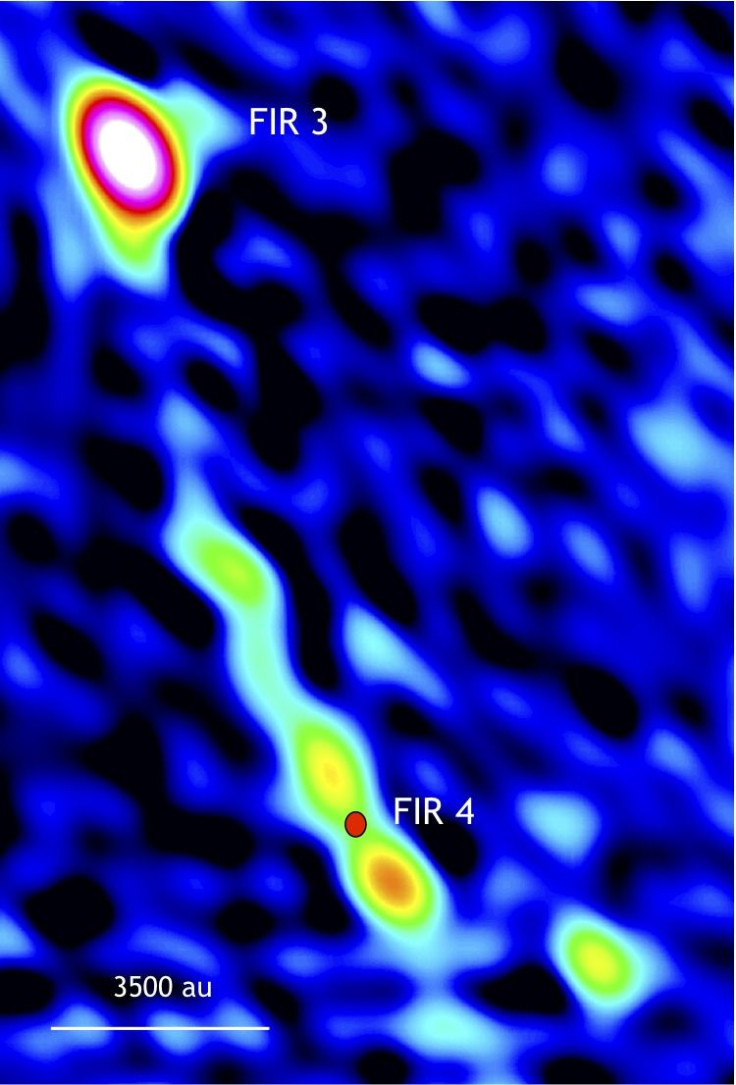Birth Of A Star Likely Spawned Formation Of Another Protostar

The formation of new stars can sometimes be triggered by other newly formed stars in the vicinity, even though vicinity can mean a few billion miles in the cosmic sense, astronomers have found. Observations of two young stars suggested “a jet of fast-moving material ejected from one young star may have triggered the formation of another, younger protostar.”
An international team of researchers used the Karl G. Jansky Very Large Array (VLA) radio telescope in New Mexico to observe a prolific star-forming region 1,400 light-years away that appears in the Orion constellation. Numerous new stars are being formed in the massive cloud of gas and dust, and observations at different radio frequencies showed a possible relationship between the births of two stars.
Read: All Stars Are Born In Pairs, And The Sun Had A Twin Long Ago, Study Finds
A young protostar, named HOPS 108 (found as a part of the Herschel Orion Protostar Survey), was found to be in the path of the jet outflow from a relatively older young star called HOPS 370. The idea that the alignment was suggestive of HOPS 108 being born as a result of the impact from the shock of the HOPS 370 jet hitting a clump of gas was first put forth in 2008 by Yoshito Shimajiri of the University of Tokyo. The new measurements lend weight to that theory.
Mayra Osorio from the Astrophysical Institute of Andalucia (IAA-CSIC) in Spain was the lead author of a recent paper based on the VLA observations. In a statement published Tuesday on the website of the National Radio Astronomy Observatory, Osorio said: “The orientation of the jet, the speed of its material, and the distance all are right for this scenario.”
In the paper, the astronomers say the jet outflow from HOPS 370 reached a clump of gas — that likely later became HOPS 108 — about 100,000 years ago. Four more stars in the region could have also been formed by similar interactions, but evidence of the shock has so far been found only in the case of HOPS 108 (also called FIR 4).
“We found knots of material within this outflow and were able to measure their speeds,” Ana K. Diaz-Rodriguez, also of IAA-CSIC, said in the statement. The knots are found at distances ranging from 7,500 AU (1 AU, or astronomical unit, is about 93 million miles, the distance between Earth and the sun) to 12,500 AU from HOPS 370 (also known as FIR 3), and these knots are moving away from the FIR 3 at speeds of about 100 kilometers (62 miles) per second.
Read: Newly Formed Stars Can Have Chaotic Magnetic Fields
There is, however, one fact about the motion of FIR 4 that contradicts the evidence of it being formed by the shock impact of the jet from FIR 3. The younger star’s rapid movement is of a nature that suggests it formed in a region outside the path of the older star’s outflow.
“This motion, however, might be an illusion possibly created by an outflow from the newer star itself,” explained Osorio. “We want to continue to observe it over a period of time to resolve this question.”
The study published by Osorio and others in the Astrophysical Journal is titled “Star Formation Under the Outflow: The Discovery of a Non-thermal Jet from OMC-2 FIR 3 and Its Relationship to the Deeply Embedded FIR 4 Protostar.”
© Copyright IBTimes 2024. All rights reserved.





















